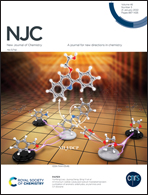Chiral diphenylacrylonitrile–perylene liquid crystal with circularly polarized luminescence in the aggregated state†
Abstract
Although various perylene derivatives have been studied widely, circularly polarized luminescence (CPL) perylenes in the aggregated state are seldom presented due to the ACQ effect. In this study, a novel diphenylacrylonitrile–perylene derivative with peripheral chiral alkyl chains (CPL-P) was designed and prepared in 81% yield. CPL-P showed Colh mesophase with a wide mesomorphic temperature ranging from 42.8 °C to 155.6 °C. Its photophysical studies suggested good fluorescence emission (550–700 nm) in the aggregated state due to the AIE-FRET effect between the diphenylacrylonitrile unit and perylene skeleton. The chiral optical investigation implied that CPL-P exhibited excellent CPL emission in the aggregated state, which could be attributed to the favourable influence of the AIE-FRET effect and the effective chiral transfer from chiral alkyl chains to the perylene skeleton based on the spiral columnar mesophase. This work not only presents a novel perylene derivative with a good CPL property in the aggregated state, but also opens a new strategy of combining the AIE-FRET effect and chiral transfer based on mesomorphic self-assembly to construct normal dye derivatives with excellent CPL property in the aggregated state.



 Please wait while we load your content...
Please wait while we load your content...